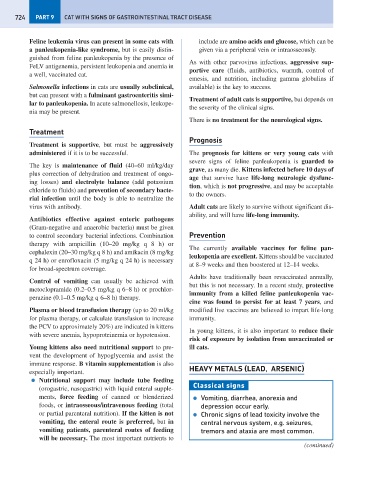Page 732 - Problem-Based Feline Medicine
P. 732
724 PART 9 CAT WITH SIGNS OF GASTROINTESTINAL TRACT DISEASE
Feline leukemia virus can present in some cats with include are amino acids and glucose, which can be
a panleukopenia-like syndrome, but is easily distin- given via a peripheral vein or intraosseously.
guished from feline panleukopenia by the presence of
As with other parvovirus infections, aggressive sup-
FeLV antigenemia, persistent leukopenia and anemia in
portive care (fluids, antibiotics, warmth, control of
a well, vaccinated cat.
emesis, and nutrition, including gamma globulins if
Salmonella infections in cats are usually subclinical, available) is the key to success.
but can present with a fulminant gastroenteritis simi-
Treatment of adult cats is supportive, but depends on
lar to panleukopenia. In acute salmonellosis, leukope-
the severity of the clinical signs.
nia may be present.
There is no treatment for the neurological signs.
Treatment
Prognosis
Treatment is supportive, but must be aggressively
administered if it is to be successful. The prognosis for kittens or very young cats with
severe signs of feline panleukopenia is guarded to
The key is maintenance of fluid (40–60 ml/kg/day
grave, as many die. Kittens infected before 10 days of
plus correction of dehydration and treatment of ongo-
age that survive have life-long neurologic dysfunc-
ing losses) and electrolyte balance (add potassium
tion, which is not progressive, and may be acceptable
chloride to fluids) and prevention of secondary bacte-
to the owners.
rial infection until the body is able to neutralize the
virus with antibody. Adult cats are likely to survive without significant dis-
ability, and will have life-long immunity.
Antibiotics effective against enteric pathogens
(Gram-negative and anaerobic bacteria) must be given
to control secondary bacterial infections. Combination Prevention
therapy with ampicillin (10–20 mg/kg q 8 h) or
The currently available vaccines for feline pan-
cephalexin (20–30 mg/kg q 8 h) and amikacin (8 mg/kg
leukopenia are excellent. Kittens should be vaccinated
q 24 h) or enrofloxacin (5 mg/kg q 24 h) is necessary
at 8–9 weeks and then boostered at 12–14 weeks.
for broad-spectrum coverage.
Adults have traditionally been revaccinated annually,
Control of vomiting can usually be achieved with
but this is not necessary. In a recent study, protective
metoclopramide (0.2–0.5 mg/kg q 6–8 h) or prochlor-
immunity from a killed feline panleukopenia vac-
perazine (0.1–0.5 mg/kg q 6–8 h) therapy.
cine was found to persist for at least 7 years, and
Plasma or blood transfusion therapy (up to 20 ml/kg modified live vaccines are believed to impart life-long
for plasma therapy, or calculate transfusion to increase immunity.
the PCV to approximately 20%) are indicated in kittens
In young kittens, it is also important to reduce their
with severe anemia, hypoproteinemia or hypotension.
risk of exposure by isolation from unvaccinated or
Young kittens also need nutritional support to pre- ill cats.
vent the development of hypoglycemia and assist the
immune response. B vitamin supplementation is also
HEAVY METALS (LEAD, ARSENIC)
especially important.
● Nutritional support may include tube feeding
Classical signs
(orogastric, nasogastric) with liquid enteral supple-
ments, force feeding of canned or blenderized ● Vomiting, diarrhea, anorexia and
foods, or intraosseous/intravenous feeding (total depression occur early.
or partial parenteral nutrition). If the kitten is not ● Chronic signs of lead toxicity involve the
vomiting, the enteral route is preferred, but in central nervous system, e.g. seizures,
vomiting patients, parenteral routes of feeding tremors and ataxia are most common.
will be necessary. The most important nutrients to
(continued)

